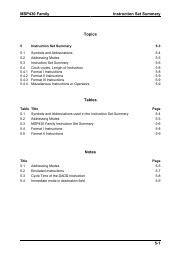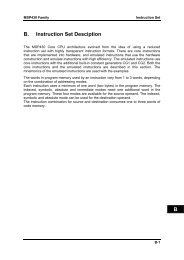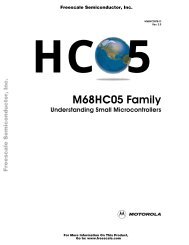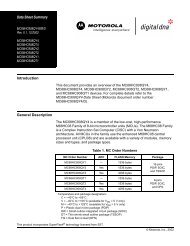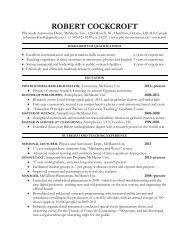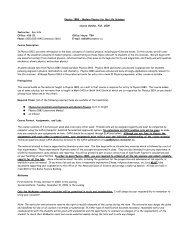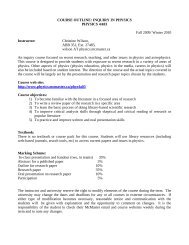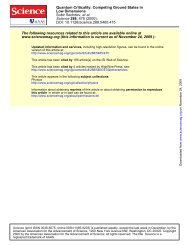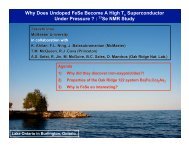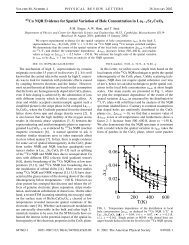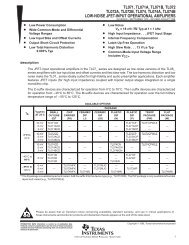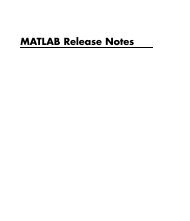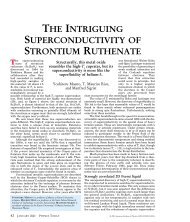Lecture 9 - McMaster Physics and Astronomy
Lecture 9 - McMaster Physics and Astronomy
Lecture 9 - McMaster Physics and Astronomy
You also want an ePaper? Increase the reach of your titles
YUMPU automatically turns print PDFs into web optimized ePapers that Google loves.
<strong>Lecture</strong> 9 (Schroeder, chapter 4.1-4.2).<br />
Reversible <strong>and</strong> Irreversible Processes.<br />
Carnot Cycle.<br />
Carnot Cycle with Ideal Gas.<br />
First Carnot Theorem.<br />
Second Carnot Theorem.<br />
We defined a quasistatic process as a process that is a succession of<br />
equilibrium states. It could stop at any stage <strong>and</strong> the system would stay where it is. Let<br />
me consider an even narrower class of processes. A reversible process is a process<br />
under which the system can be returned to its original state without any change in<br />
the surroundings.<br />
Reversible processes are always quasistatic but the converse is not always true.<br />
For example, an infinitesimal compression of a gas in a cylinder where there exists<br />
friction between the piston <strong>and</strong> the cylinder is a quasistatic, but not reversible process.<br />
Although the system has been driven through the succession of equilibrium states, heat<br />
has been irreversibly lost due to friction, <strong>and</strong> cannot be recovered by simply moving the<br />
piston infinitesimally in the opposite direction.<br />
Finally, we can say that a reversible process is a quasistatic process where no<br />
dissipative forces are present.<br />
The Carnot cycle is a cyclic process in which a working substance takes heat<br />
reversibly from a reservoir at a constant temperature T h , exp<strong>and</strong>s adiabatically <strong>and</strong><br />
reversibly to a lower temperature T c , gives up heat reversibly to a reservoir at this<br />
temperature, <strong>and</strong> finally compressed reversibly <strong>and</strong> adiabatically to its original state. The<br />
working substance may be a solid, liquid or gas (ideal or not). It may even change from<br />
one phase to another during the cycle.
Let me consider the Carnot engine using an ideal gas as the working substance<br />
(see figure below), <strong>and</strong> determine its efficiency, e (problem 4.5 in the textbook).<br />
⎛V<br />
⎞<br />
W ' =<br />
⎜<br />
b<br />
ab nRTh<br />
ln<br />
⎟ , W ' b c = CV<br />
( Th<br />
−Tc<br />
),<br />
⎝Va<br />
⎠<br />
⎛V<br />
⎞<br />
⎜<br />
b<br />
Qab<br />
= nRTh<br />
ln ⎟ , Q bc = 0 ,<br />
⎝Va<br />
⎠<br />
⎛V<br />
⎞<br />
⎜<br />
d<br />
W ' cd = nRTc<br />
ln<br />
⎟ ,<br />
⎝ Vc<br />
⎠<br />
W ' da = CV<br />
( Tc<br />
−Th<br />
);<br />
⎛V<br />
⎞<br />
⎜<br />
d<br />
Qcd<br />
= nRTc<br />
ln ⎟ ,<br />
⎝ Vc<br />
⎠<br />
Q da = 0 .<br />
b<br />
d<br />
Th<br />
ln Tc<br />
W ab W bc W cd W<br />
⎜<br />
da<br />
V<br />
⎟ + ln<br />
⎜<br />
a V<br />
⎟<br />
' net ' + ' + ' + '<br />
c Th<br />
−Tc<br />
Tc<br />
=<br />
=<br />
⎝ ⎠ ⎝ ⎠<br />
= = − .<br />
h<br />
Qab<br />
⎛Vb<br />
⎞ Th<br />
Th<br />
Th<br />
ln<br />
⎜<br />
V<br />
⎟<br />
a<br />
W<br />
e = 1<br />
Q<br />
We used that points b <strong>and</strong> c lie on the same adiabat, so do points d <strong>and</strong> a, i.e.<br />
T<br />
T<br />
( γ −1) 1/<br />
V T<br />
( γ 1<br />
=<br />
)<br />
V ,<br />
1/<br />
−<br />
h b c<br />
( γ −1) 1/<br />
V T<br />
( γ 1<br />
=<br />
)<br />
V<br />
1/<br />
−<br />
h a c<br />
<strong>and</strong>, as a result, V V = V V .<br />
b<br />
a<br />
c<br />
d<br />
c<br />
d<br />
.<br />
⎛V<br />
If the cycle is operated in the reverse direction, so that we have a Carnot<br />
Qc<br />
Tc<br />
refrigerator, the coefficient of performance is COP = = .<br />
W T − T<br />
⎞<br />
⎝<br />
net<br />
⎠<br />
⎛V<br />
h<br />
⎞<br />
c
First Carnot Theorem:<br />
all Carnot engines operating between two reservoirs at constant temperatures have the<br />
same efficiency.<br />
Proof: Let us suppose that there are two Carnot engines having efficiencies e <strong>and</strong> e ' ,<br />
both of which operate between reservoirs at temperatures T h <strong>and</strong> T c . Furthermore let us<br />
suppose that<br />
e > e'<br />
. Carnot cycle is reversible. Therefore, the second engine e ' can be<br />
operated as a refrigerator. It can also be arranged that the work output of the heat engine<br />
provides the work input to the refrigerator.<br />
Since<br />
e > e'<br />
by assumption, we have<br />
Qh<br />
− Q<br />
Q<br />
h<br />
c<br />
Q' h −Q'<br />
><br />
Q'<br />
In writing e ' in this way we are using the fact that<br />
h<br />
c<br />
.<br />
Q' h <strong>and</strong><br />
Q' c in the refrigerator mode<br />
are numerically equal to the heats absorbed <strong>and</strong> expelled at the heat reservoirs when the<br />
device is operated in the heat engine mode.
Qh<br />
− Q<br />
Then:<br />
Q<br />
Since<br />
Q<br />
Q' h −Q'<br />
><br />
Q'<br />
W<br />
Q<br />
W<br />
> →<br />
'<br />
1 1 > → Q h Q'<br />
Q h Q'<br />
h<br />
h<br />
c<br />
c<br />
→<br />
h<br />
h h Q h<br />
h − Q c = Q' h −Q'<br />
c , we have Q'<br />
h − Qh<br />
= Q'<br />
с −Qс<br />
< → Q ' Q > 0 .<br />
h − h<br />
. Hence our assumption that<br />
e > e' leads to the conclusion that both Q' h −Qh<br />
<strong>and</strong> Q'<br />
с −Qс<br />
are positive quantities. This<br />
implies that the engine-refrigerator combination, regarded as a single device, has the net<br />
effect of transferring an amount of heat<br />
Q'<br />
с<br />
−Q<br />
с<br />
per cycle from the cold reservoir to the<br />
hot reservoir, thereby violating the Clausius statement of the second law. Therefore, the<br />
original assumption<br />
assumption<br />
possibility is that<br />
e > e'<br />
must be false. The same line of reasoning starting from the<br />
e ' > e also leads to a contradiction of the second law. Therefore, the only<br />
e = e'<br />
.<br />
In particular, the first Carnot theorem states that the efficiency of a Carnot engine<br />
doesn’t depend on a working substance.<br />
Second Carnot Theorem:<br />
no heat engine operating in cycles between two reservoirs at constant<br />
temperatures can have a greater efficiency than a Carnot engine operating<br />
between the same two reservoirs: ( Qh<br />
Qc<br />
) Qh<br />
≤ ( Th<br />
−Tc<br />
) Th<br />
− .<br />
Proof: Suppose that there existed an irreversible engine of efficiency e irr such that<br />
e irr > e , where e is the efficiency of any reversible engine operating between the same<br />
temperatures T h <strong>and</strong> T c . If the preceding proof, summarized in Figure 2, is modified so<br />
that the reversible engine operating in the heat-engine mode is replaced by the<br />
irreversible engine, then the same line of argument starting from<br />
e irr > e leads to a<br />
contradiction of the Clausius statement of the second law. Hence, we must conclude that<br />
e irr ≤ e .<br />
Notice that although a Carnot cycle is very efficient, it is also horribly impractical.<br />
The heat flows so slowly during the isothermal steps that it takes forever to get a<br />
significant amount of work out of the engine. So don’t bother installing a Carnot engine<br />
in your car; while it would increase your gas mileage, you’d be passed by pedestrians.



